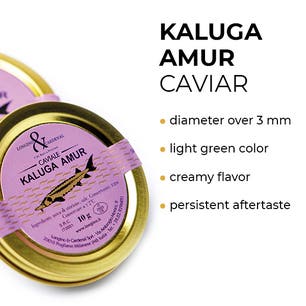Caviar History
CAVIAR
The history of caviar: ancient origins and the production in Central Asia
Caviar is a prized food with a long and fascinating history. This delicious food, originally from Eastern Europe, has been considered a symbol of luxury and status for many centuries.
Its history dates back to at least the 10th century, when nomadic peoples in Central Asia began fishing for perch from the Caspian Sea and extracting its eggs to preserve them in brine. Later, the preparation of caviar became increasingly refined and spread throughout the region. At that time, the most widely used fish for caviar production were perch (particularly the subspecies "acipenser persicus") and sturgeon (particularly the species "acipenser stellatus").
To extract fish eggs, nomads used simple but effective techniques. After catching the fish, they extracted the eggs, which were then placed in brine for preservation. This preservation technique allowed the caviar's flavor and texture to remain intact for long periods of time.
Caviar produced by the nomads of Central Asia was already a highly valued food throughout the world and was exported in large quantities to Europe and the Middle East. In particular, Venice and Genoa became important centers of caviar exchange and trade in the Mediterranean.
Caviar is still highly valued worldwide as a culinary delicacy, but its consumption is often restricted for sustainability and ethical reasons. In many countries, the marketing of caviar made from endangered sturgeon species is prohibited, and it is important to choose producers who comply with environmental and animal protection regulations.




Caviar in the Russian Empire: symbol of wealth and power of the nobility
During the Russian Empire, caviar became a popular food among the nobility and members of the tsarist court. This prized food was often served in large quantities at royal banquets, and was considered a symbol of wealth and power.
Caviar production in Russia began in the 18th century, when sturgeon from the Caspian Sea were imported to feed the people of the Volga region. Thereafter, fishing and caviar production developed quickly, becoming an important economic resource for the Russian Empire.
During the reign of Catherine the Great, caviar became even more popular and production was concentrated in the Don region, where the prized Astrakhan caviar was produced. Caviar production in Russia continued to grow during the 19th century, and it became one of the country's major exports.
However, excessive sturgeon hunting and declining fish populations led to a reduction in caviar production during the 20th century. In 1967, the Soviet government banned sturgeon fishing in the Caspian Sea, and caviar production in Russia declined dramatically.
Today, caviar production in Russia is much more controlled and sustainable than in the past. There are many varieties of caviar available on the market, which differ in taste, color, and texture, depending on the species of fish used and the production process. Despite the reduction in caviar production, this prized food continues to be highly valued in Russia and around the world.


Caviar regulations and protection
In the 1960s and 1970s, many governments began to worry about declining populations of sturgeon, the fish species most used to produce caviar. This led to the adoption of legislation to regulate fishing and protect the remaining species.
In 1973, the Convention on the Conservation of Migratory Species of Wild Animals (CMS) was signed, which aimed to protect endangered species and regulate caviar production. This convention was signed by many caviar-producing countries, including Russia, Iran, and Kazakhstan.
In addition, many countries introduced national laws to protect species and restrict caviar production. For example, in 1973 the United States banned the import of Beluga caviar, the largest and most valuable type, and in 1998 the European Union banned the import of caviar of certain endangered species.
This regulation led to a reduction in caviar production and an increase in the price on the market. However, it also allowed for the survival of the remaining species and promoted sustainability in caviar production. Today, caviar production is still regulated internationally and nationally.
Caviar production is still very controlled and sustainable compared to the past, and many producers work to ensure the quality and sustainability of their product. For example, some producers use freshwater tank farming techniques, which reduce the environmental impact of caviar production and ensure the quality of the product.


How to produce sustainable caviar
The production of caviar can be sustainable and responsible if certain practices are adopted that do not harm the ecosystem and ensure the conservation of sturgeon species. One of the most effective ways to produce caviar sustainably is through the cultivation of sturgeon in freshwater tanks. This type of farming reduces the environmental impact of caviar production and ensures the quality of the product. Additionally, cultivating sturgeon in freshwater tanks helps to avoid overfishing and protect fish populations.
Another way to produce caviar sustainably is through controlled sturgeon breeding. This technique allows for the selection of the best fish and the conservation of species, ensuring the continuity of caviar production. It is also important for caviar producers to comply with environmental and animal welfare regulations. For example, they should avoid using harmful chemicals and ensure the welfare of animals throughout the production process. Finally, product traceability is a crucial element in ensuring the sustainability of caviar production. Caviar producers should provide detailed information on the origin of the product and the production practices used, to ensure its sustainability and responsibility.
Discover the products
Longino & Cardenal
Longino & Cardenal stands today as one of Italy's leading "food globetrotters." With passion and courage it carries out a continuous search for the best raw materials, often little known to most, in order to meet the new trends in consumer behavior that seek excellent products proposed in innovative forms. Delivery of products is expected in 48/72 hours from the order if the product is already in stock. All our deliveries use specialized, refrigerated couriers.






